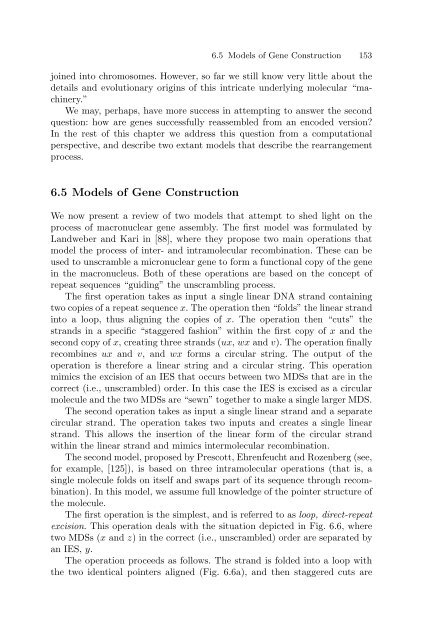Theoretical and Experimental DNA Computation (Natural ...
Theoretical and Experimental DNA Computation (Natural ...
Theoretical and Experimental DNA Computation (Natural ...
Create successful ePaper yourself
Turn your PDF publications into a flip-book with our unique Google optimized e-Paper software.
6.5 Models of Gene Construction 153<br />
joined into chromosomes. However, so far we still know very little about the<br />
details <strong>and</strong> evolutionary origins of this intricate underlying molecular “machinery.”<br />
We may, perhaps, have more success in attempting to answer the second<br />
question: how are genes successfully reassembled from an encoded version?<br />
In the rest of this chapter we address this question from a computational<br />
perspective, <strong>and</strong> describe two extant models that describe the rearrangement<br />
process.<br />
6.5 Models of Gene Construction<br />
We now present a review of two models that attempt to shed light on the<br />
process of macronuclear gene assembly. The first model was formulated by<br />
L<strong>and</strong>weber <strong>and</strong> Kari in [88], where they propose two main operations that<br />
model the process of inter- <strong>and</strong> intramolecular recombination. These can be<br />
used to unscramble a micronuclear gene to form a functional copy of the gene<br />
in the macronucleus. Both of these operations are based on the concept of<br />
repeat sequences “guiding” the unscrambling process.<br />
The first operation takes as input a single linear <strong>DNA</strong> str<strong>and</strong> containing<br />
two copies of a repeat sequence x. The operation then “folds” the linear str<strong>and</strong><br />
into a loop, thus aligning the copies of x. The operation then “cuts” the<br />
str<strong>and</strong>s in a specific “staggered fashion” within the first copy of x <strong>and</strong> the<br />
second copy of x, creating three str<strong>and</strong>s (ux, wx <strong>and</strong> v). The operation finally<br />
recombines ux <strong>and</strong> v, <strong>and</strong> wx forms a circular string. The output of the<br />
operation is therefore a linear string <strong>and</strong> a circular string. This operation<br />
mimics the excision of an IES that occurs between two MDSs that are in the<br />
correct (i.e., unscrambled) order. In this case the IES is excised as a circular<br />
molecule <strong>and</strong> the two MDSs are “sewn” together to make a single larger MDS.<br />
The second operation takes as input a single linear str<strong>and</strong> <strong>and</strong> a separate<br />
circular str<strong>and</strong>. The operation takes two inputs <strong>and</strong> creates a single linear<br />
str<strong>and</strong>. This allows the insertion of the linear form of the circular str<strong>and</strong><br />
within the linear str<strong>and</strong> <strong>and</strong> mimics intermolecular recombination.<br />
The second model, proposed by Prescott, Ehrenfeucht <strong>and</strong> Rozenberg (see,<br />
for example, [125]), is based on three intramolecular operations (that is, a<br />
single molecule folds on itself <strong>and</strong> swaps part of its sequence through recombination).<br />
In this model, we assume full knowledge of the pointer structure of<br />
the molecule.<br />
The first operation is the simplest, <strong>and</strong> is referred to as loop, direct-repeat<br />
excision. This operation deals with the situation depicted in Fig. 6.6, where<br />
two MDSs (x <strong>and</strong> z) in the correct (i.e., unscrambled) order are separated by<br />
an IES, y.<br />
The operation proceeds as follows. The str<strong>and</strong> is folded into a loop with<br />
the two identical pointers aligned (Fig. 6.6a), <strong>and</strong> then staggered cuts are







